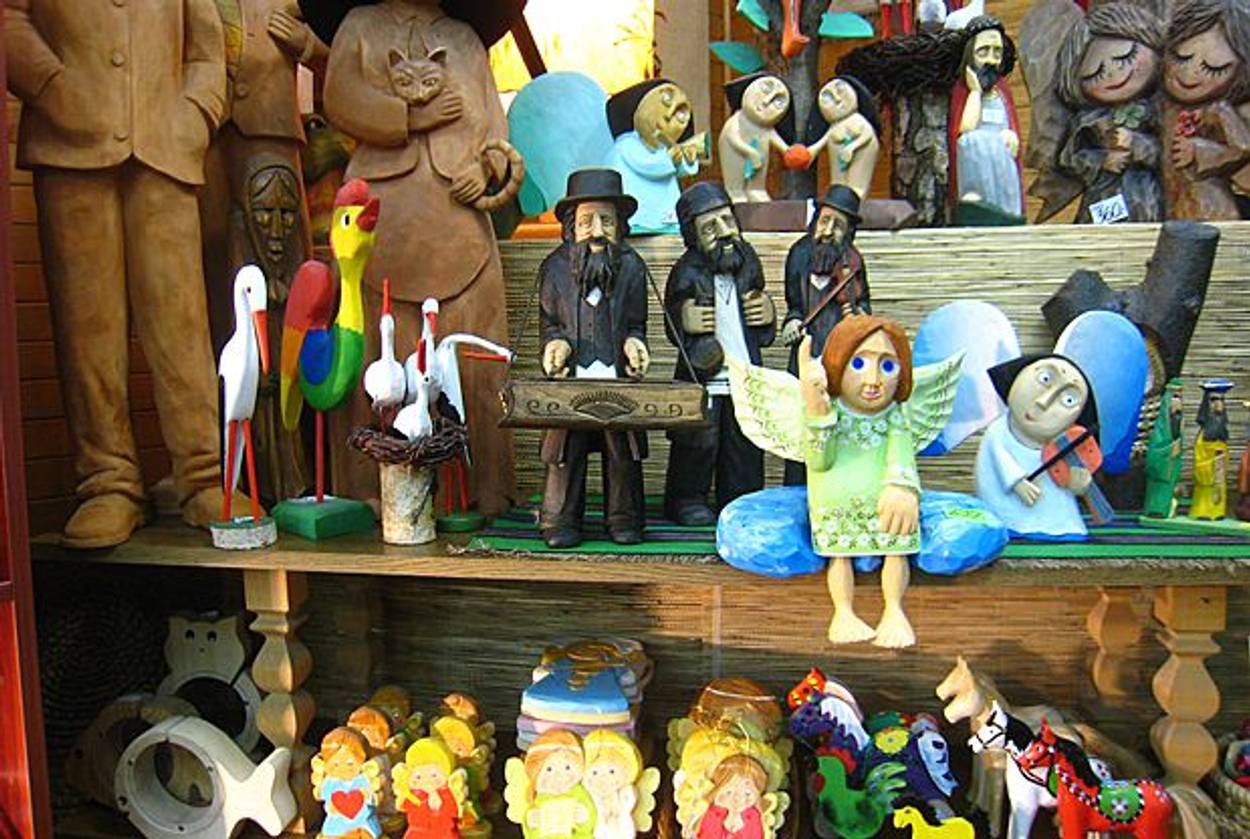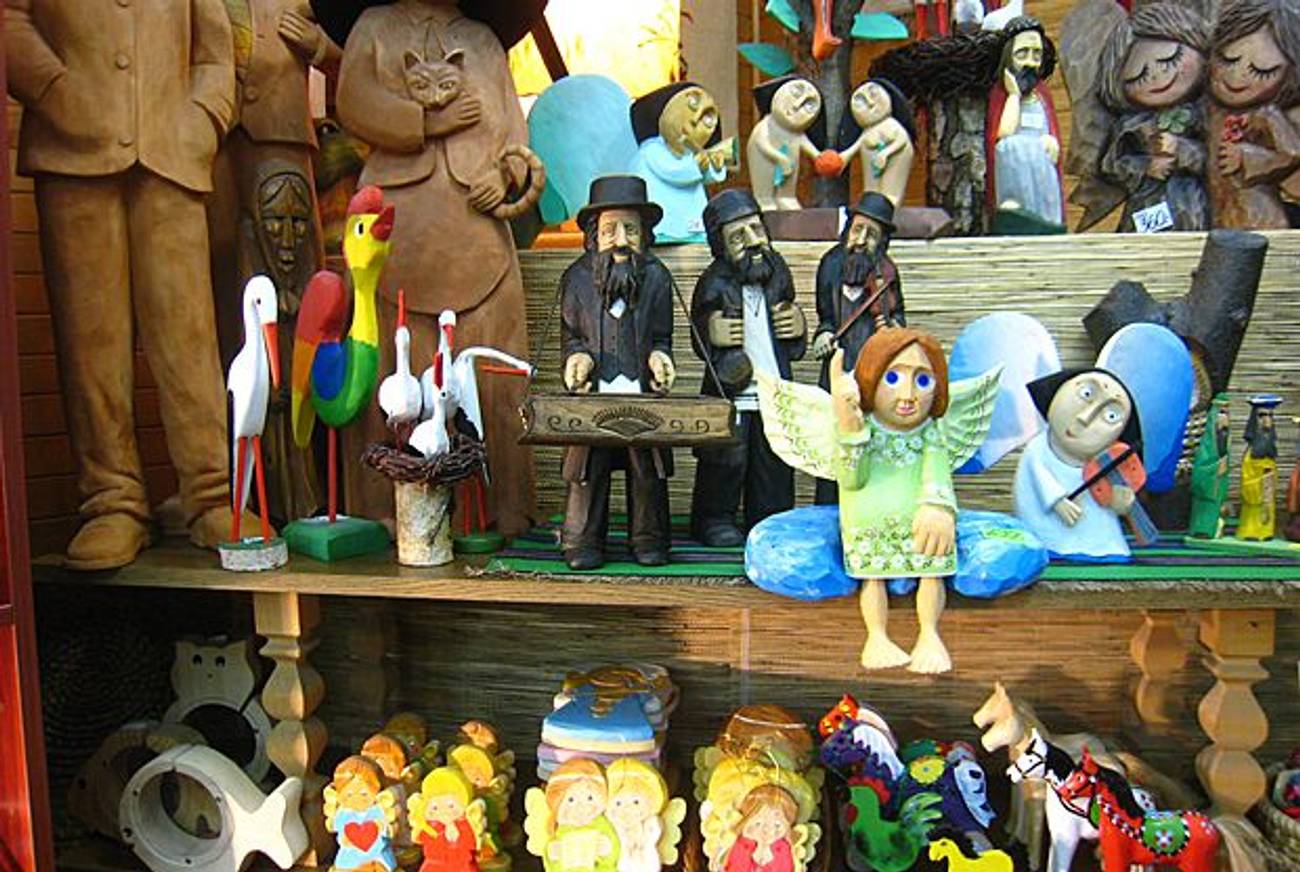Popular Images of Jews in Krakow: Folk Art or Stereotypical Caricatures?
Exhibit challenged locals and visitors alike to rethink controversial figurines




“Everybody wants to be a Rothschild,” an older Polish woman joked as we gazed at the wooden figurine holding a gold coin. These figurines are recognizable to many people who have been to Poland: they depict stereotypically devout Jews holding objects such as prayer books, musical instruments, or, more notably in recent decades, coins or bags of money. They provoke a wide range of responses from locals and visitors who see them for sale at markets and souvenir shops across the country.
Those varied reactions were what we hoped for that day last August, as I led a discussion at the Galicia Jewish Museum in Krakow, about a controversial exhibit, Souvenir, Talisman, Toy. The exhibit opened earlier that month during the city’s annual Jewish Culture Festival, and I had been involved with it for the past year. Curated by Professor Erica Lehrer of Concordia University, the participatory exhibit examined the phenomenon and history of the ubiquitous Jewish figurines in Poland. On one hand, it showed how these figurines have pre-war folk art roots and are widely perceived in Poland as bringing good luck to their owners. It also underscored how they are jarring images for some who visit the country, considering the decimation of Poland’s pre-Holocaust Jewish population of 3.5 million, now estimated to be somewhere around 20,000.
There were about 15 of us at that day’s event, an unlikely smattering of people—older locals, a Jewish Australian couple, a well-known social anthropologist, and my Polish boyfriend, who served as our translator. The controversial figurines were a perfect jumping-off point for discussion, particularly between the Poles in the group and the visiting tourists. As I’ve come to realize after living in Poland for over two years and traveling here for six, there is no way to simplify the nuanced layers of memory and stereotype embedded in these images. Ours was an ideal setting to engage with this firsthand.
“It is difficult for Jews not to think about the Holocaust when we talk about Jews in Poland,” the Australian couple articulated, a statement which echoed feedback I’ve heard frequently. The older locals listened intently to the translation, and nodded. When it comes to the figurines—which range from folk-inspired wooden carvings to kitschy plastic caricatures—many visitors to Poland are taken aback or offended by the association between Jews and money.
Discussions such as this have emphasized important questions: Is stereotyping, as these figurines may seem to do, synonymous with anti-Semitism? In my opinion, no. In Poland, a pre-war perception of Jews as the “Other” was reinforced by their virtual disappearance during the Holocaust—something that wasn’t formally discussed until after the fall of the Communist regime decades later. Only in the 1980s, thanks to the influence of Solidarity and democratic political changes, could the topic of Judaism re-emerge in the public sphere—and with great force, as evidenced by the boom of Jewish Studies programs at major local universities, the proliferation of Jewish publications, Jewish culture festivals, and a breadth of cultural initiatives, such as Krakow’s Jewish Community Centre and the Auschwitz Jewish Center, an organization with which I work.
As participants left the exhibit discussion, the consensus was that it exposed them to new perspectives. It also raised another question: can we do this more often? All this openness—or openness to openness—started decades ago. Yet inevitably, Poland’s history still carries an inexorable scar, and outsiders often can’t look past that. I don’t mean to imply that there was or is no anti-Semitism; that’s certainly not true. However, I can say that as a Jew living in Poland I personally have never had a negative or threatening experience; my involvement with the local community and Polish people has only reinforced a sense of respect and an overwhelming curiosity.
My Master’s thesis examined this post-war evolution through the figurines, and I had the opportunity to interview many different people who made, bought, or sold images of Jews with coins—including artists who create legitimate art (not just tourist kitsch—you can tell the difference) and store owners. Throughout my research, figurines I received from artists I met with lived on my dresser; the reactions of dozens of house guests, mostly local Polish friends and visiting Americans, reflected the ambivalence the figures evoke.
Friends often asked who made them. One piece was designed by a Polish-Jewish survivor who made sculptures after the war and consulted with Polish artisans on their designs. He told me the folk images weren’t anti-Semitic. “I remember the Jews,” he said. “I remember before the war, there were only Jews here. And now there’s nothing.” Another contemporary Polish Catholic folk artist carves figurines from trees he has hand-selected. “I have a lot of respect for the history,” he told me. “I’m upset that there’s nothing left except memories.”
While there are many welcoming forums to discuss Jewish topics in Poland, particularly in the historically Jewish quarter of Krakow in which I lived, a pause often creeps in when—outside communal and educational contexts—one brings up anything Jewish. Even the word Jew in Polish—Żyd—bears a slightly pejorative undertone, and some even avoid it by using outdated terms: Izraelita (Israelite), osoba wyznania mojżeszowego (a person of the Mosaic persuasion), or starozakonny (older brother in faith, literally “adherent of the old order”). When the terminology itself is opaque and sometimes untranslatable, it can be difficult to start a discussion.
To many of my Polish friends, I am one of, if not the only, Jew they know. For the first time in their lives, they can comfortably ask a Jewish person questions. For example: “How is the ritual slaughter ban affecting Polish Jews?” Questions like this arise, and I explain as best I can. People—Polish-Jewish friends, too—want to know what it was like growing up as an American Jew, and what it means that I don’t keep kosher or pray. Sometimes it’s more intense: “Can you read these Hebrew documents we found after my grandparents died?” It’s these conversations, these honest, open interactions, that have been the most meaningful part of my time in Poland.
The Souvenir, Talisman, Toy exhibit, too, hinged on the power of informal dialogue, encouraging visitors to contribute written and recorded thoughts throughout the exhibition as well as online afterwards. The “Exhibition Dialogue Team,” which I co-managed, was tasked with encouraging visitors to engage with the material, and share their impressions. The responses we got surprised, challenged, and encouraged us. It also confirmed the power of dialogue. Local storeowners I interviewed perceived selling the figurines as a way of honoring the local history—many were shocked it could be seen as offensive, even asking if they should stop selling them. The exhibit provoked a similar response from various local visitors I spoke with or who gave written feedback. Many expressed surprise and gratitude to have learned that another interpretation even existed.
Within these open forums, I’ve watched people transform their opinions and biases—or at least start the process of doing so. A relatable approach allows real people—not just academics—to join a discussion that may seem otherwise inaccessible. People will talk, if there is a dedicated space to do so. Dialogue, I’ve found, can be the most valuable, enlightened, and underused tactic towards reconciling both memory and progress.
Dara Bramson is a journalist covering Eastern Europe and Southeast Asia.